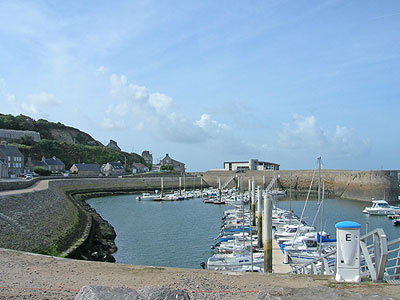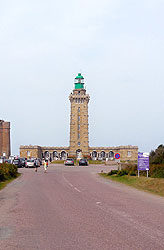 |
| The Independent Traveler's Newsletter PAGE FIVE |
 |
| The Independent Traveler's Newsletter PAGE FIVE |
| FEATURING: Lighthouses on the Coast of Normandy and Brittany | |
|
The first lighthouse on the point
was known as Phare de Barfleur which opened in 1774 and was lit
the following year with a coal fire located on top. Sixteen oil
lamps replaced the coal fire in 1780 and reflectors were
installed. It wasn't until an upgrade of the lens was planned in
1825 that it was realized the structure wasn't wide enough. The
newer, taller, lighthouse was built about 60 meters away from the first
(which remains on the site), and in 1881 it was renamed Phare de
Gatteville. In 1883 the light itself was replaced with an
electric lantern. Phare de Gatteville was open to the public until 1996 when it was closed for renovation. The following year it reopened as a museum. In the photo above of Barfleur and its harbor, the lighthouse can be barely seen on the right of the photo on the land reaching into the sea.  While Barfleur is at the
northeastern tip of the
Cotentin, Goury and the larger town of Auderville, are near the
northwestern tip. There, too, is a
lighthouse, the photo of which appears on the first page of this
newsletter. The location is known as Cap de la Hague, and the
lighthouse is Phare de Goury or Phare de la Hague, depending on what
one wants to call it. The 157-foot tall granite lighthouse was
built between 1834 and 1837 and was
fully automated in 1989. There is no keeper and no visitors are
allowed. While Barfleur is at the
northeastern tip of the
Cotentin, Goury and the larger town of Auderville, are near the
northwestern tip. There, too, is a
lighthouse, the photo of which appears on the first page of this
newsletter. The location is known as Cap de la Hague, and the
lighthouse is Phare de Goury or Phare de la Hague, depending on what
one wants to call it. The 157-foot tall granite lighthouse was
built between 1834 and 1837 and was
fully automated in 1989. There is no keeper and no visitors are
allowed.It is here that you will find one of the strongest tidal currents in the world ~ the Race of Alderney ~ caused by an uneven seabed and the narrow channel between Cap de la Hague and the Channel Islands. There were 27 shipwrecks along this stretch of coast in 1823 alone, but it wasn't until fourteen years later that the lighthouse became a reality. Surprisingly, Cap de la Hague is the second most visited place in Normandy after le Mont St-Michel according to the web site www.encotentin.com and a cross is there in memory of the 25 sailors lost in the Vendémiaire shipwreck on June 8, 1912. Tiny village and marina of Goury on Cap de la Hague  Lunchtime one day brought us to the little seaside town of Diélette, after passing the huge Flamanville Nuclear plant at Cap de Flamanville. As we enjoyed lunch in a little restaurant, our view was that of the Diélette Lighthouse (Phare de Diélette) at the entrance to the Diélette Basin. In the 1830s, lighthouse commissioners didn't see a need for a lighthouse at this spot on the coast, but an arrangement was made in 1839 to proceed with a structure ~ strategically placed at the only port of refuge from storms between Granville and Cherbourg. Over the years several iron towers of varying heights were installed. On the 10th of November, 1897, the current masonry turret, 8.8 meters in height, was erected. In 1906 it received an automatic light which operates in white, green and red every four seconds. Diélette has a sheltered marina lined with fishing shops and is a point of passenger embarkation to both Jersey and Guernsey in the Channel Islands. With an inner and outer harbor there are 420 floating moorings, 70 of which are for tourists, and it is here that the green and white lighthouse stands sentinel. .  Diélette Harbor in September Brittany ~ We drove from
Normandy into Brittany, taking some friends to Dinan along the way, and
then we continued
along the D786 (not as close to the shore as we would have liked, but
the best route to our destination) and then the D34 through
Sables-d'Or les-Pins to the town of Plévenon and the Cap
Fréhel. It was here that we began to realize how popular
lighthouses are with travelers. The parking lots were filling up
as we arrived, and people were milling around the cliffs and looking
at both lighthouses with great interest. This map at the site shows
Brittany's Côtes
d'Armor département ~ Cap Fréhel is at the top of
the map just below the numbers 5 and 6.
As with several other lighthouse
locations, Cap Fréhel has two standing lighthouses not very far
apart from one another. But the one in service now is actually
number three. It was in
1694 that Vauban (Sébastien Le
Prestre de Vauban, later Marquis de Vauban and Marshal Vauban, famed
military engineer of France) surveyed the northern coast of Brittany
and suggested the A second lighthouse was planned in
1840 by Léonce Reynaud which included a new 22 meter high
octagonal tower that could hold Fresnel optic lenses. The
light would be seen for 25 miles. It was constructed between 1845
and 1847 and was 79 meters above sea level.
But, politics entered the matter, and electrification was abandoned by
a
ministerial decision made in 1886. In
World War II the German army used it as an observation post, but
dynamited the building on the 11th of August 1944. Only the old
Vauban tower remained standing and was kept lit until 1950. The
third and current lighthouse at Cap Fréhel (shown in the photo
below) was built between 1946 and 1950. It was first lit on July
1, 1950, and stands 32.85 meters high and 67.7 meters above sea
level. It has its tower set on a stone masonry building, and the
public can buy tickets to climb the circular metal stairs to the
observation deck at the top. There is also an elevator, but when
we were there it was out of service. Phare de Vauban, Cap Fréhel, Brittany  Both the first (Phare de Vauban) and the third (Phare du Cap Fréhel) are shown side by side in this photo, and below is the Phare du Cap Fréhel lighthouse as well as its winding stairway to the observation deck. The Phare du Cap Fréhel was electrified simultaneously with its construction in 1950, and its beam secures the passage of vessels from the Bay of Saint-Brieuc on the west to the Bay of Saint-Malo on the east ~ a very windswept area for ships. Phare du Cap Fréhel was classified a Monument Historique on May 23, 2011.
We weren't able to visit other lighthouses this time, as our journey took us away from the coast, and there were so many more noted on our map that we would have liked to see. Our stay in Brittany began at a hilltop B&B in Pléneuf-Val-André, and our host said that we could see several distant lighthouses lit at night from our balcony ~ most likely Rohein Light, built in 1939, located in the Baie de Saint Brieuc where it marks the rocks and shoals in the bay and stands 49 feet high; and the more distant Île Harbour Light, constructed in 1850 on an island one mile north of Saint Quay Portrieux ~ but, despite our view of the sea, the marine layer of clouds each night prevented us from viewing either. Hopefully, ships at sea didn't not share that problem! Perhaps you will take notice of lighthouses as you travel coastal highways. Each has a history, not only about its time in service, but about the people who had the vision, the engineering know-how and the persistence to erect lighthouses where they were needed to save lives and guide sailors safely into port. [This article is a continuation of THE
LIGHTHOUSE: A fading tradition?
from our
Spring newsletter. Click here to read
it.]
DISCLAIMER: You have received this newsletter because your email address is on our Opt-In mailing list, i.e., you have requested to receive FRANCE On Your Own ©. If you would like to discontinue receipt of this newsletter, please send an email to publisher@franceonyourown.com with "unsubscribe" on the Subject line. Unless indicated otherwise, photos, graphics, artwork and text in the FRANCE On Your Own © newsletter are all the property of Cold Spring Press and FRANCE On Your Own © and cannot be copied, duplicated or used in any manner by anyone without the express written permission of Cold Spring Press. FRANCE On Your Own © is published online by Cold Spring Press, P O Box 26098, San Diego, California 92196-0098. This publication is copyrighted and no portions of the text, artwork, graphics or photographs may be reproduced or distributed in any form or by any means or stored in a database or retrieval system without the written permission of the Publisher. For more information about FRANCE On Your Own ©, visit our web site at http://www.franceonyourown.com. Recommendations made in this newsletter are based upon the personal experiences of the Publishers or contributing writers solely to provide information to subscribers. Cold Spring Press and FRANCE On Your Own © make no endorsements nor are any guarantees or promises of satisfaction given or implied. Any and all information is correct to the best of our knowledge, and the Publishers accept no responsibility for errors and/or omissions. The responsibility lies entirely with the traveler to obtain current information regarding accommodations, availability, schedules, prices, reservations, or any other pertinent details. We do not guarantee the historical accuracy of the contents of articles in this newsletter. Historical accuracy is dependent upon one's sources of information -- and contradictions often exist among those sources. Links to other web sites or email addresses are provided for informational purposes only and do not imply any guarantees of service or endorsement of any organization or their business practices. FRANCE On Your Own © is electronically transmitted via email. To add your email address to our database for this FREE newsletter, send an email to info@franceonyourown.com, and please put Subscribe in the subject line. We do not share email addresses with any other organization. BACK ISSUES of the print version of FRANCE On Your Own © and Free online back issues are available on our web site at http://www.franceonyourown.com/Archives.htm. ©1998-2014 Cold Spring Press All Rights Reserved |
|
 previous
page
previous
page |